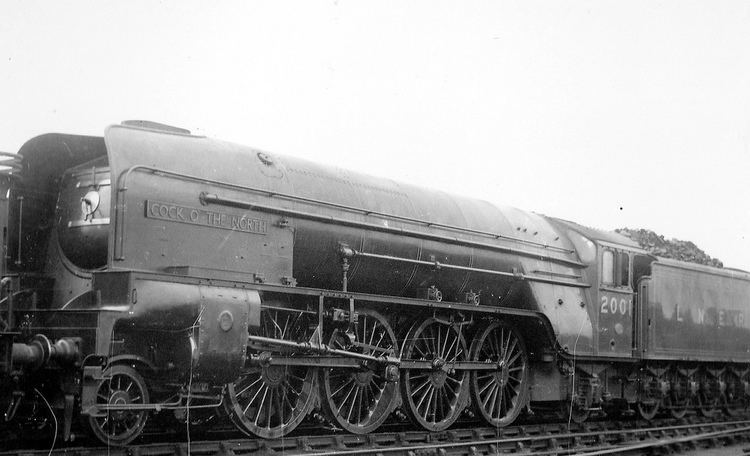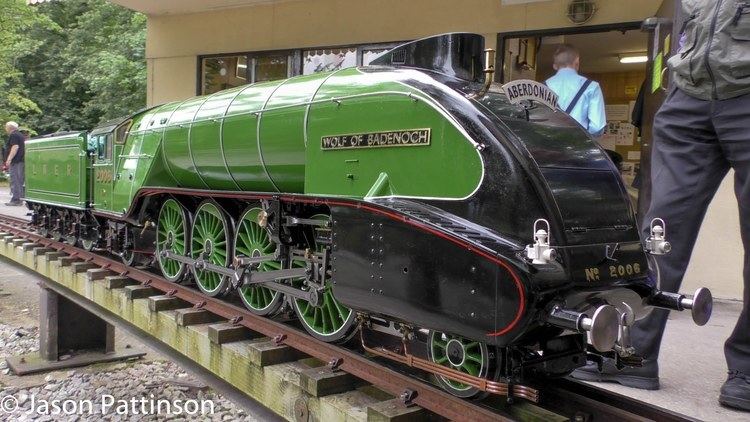Power type Steam Total produced 6 | Build date 1934-1936 | |
 | ||
5 inch gauge lner class p2 2006 wolf of badenoch live steam 2 8 2 mikado locomotive
The London and North Eastern Railway Class P2 was a class of 2-8-2 steam locomotives designed by Sir Nigel Gresley for working heavy express trains over the harsh Edinburgh to Aberdeen Line. As they were to serve on Scottish expresses, they were given famous names from Scottish lore.
Contents
- 5 inch gauge lner class p2 2006 wolf of badenoch live steam 2 8 2 mikado locomotive
- Design
- Testing performance and service
- Rebuilding
- The P2 Steam Locomotive Company
- Doncaster P2 Locomotive Trust
- Modelling
- References

Six locomotives of the class were built; introduced between 1934 and 1936. Between 1943 and 1944 the class were rebuilt under Gresley's successor Edward Thompson into the LNER Thompson Class A2/2 4-6-2 type.

Design

The locomotives were designed by Nigel Gresley to haul express trains over the difficult Edinburgh to Aberdeen section of the London and North Eastern Railway. In the design Gresley was influenced by recent French practice, in particular passenger locomotives of the Paris à Orléans railway.

The first locomotive of the class, No.2001 Cock o' the North, was introduced in 1934. It was built at Doncaster Works, with Lentz-type rotary-cam actuated poppet valve-gear supplied by the Associated Locomotive Equipment Company, and a double-chimney Kylchap exhaust, each chimney using four nozzle blastpipes. The chimney system was designed to take different fittings to allow experimentation with exhaust arrangements.

The boiler barrel was of the design used on Gresley Pacifics, fitted to a larger firebox. The front end design was of the same form as the Class W1 locomotive, No. 10000, derived from Dr. Dalby's wind tunnel research, and the attached tender was of the standard design used on Gresley Pacifics. The P2 introduced a wedge-shaped cab front end, designed to give a better view forward. The same design was used on the later A4 and V2 express engines. No. 2001 was fitted with a Crosby chime whistle which Gresley had obtained from Captain Howey of the Romney, Hythe and Dymchurch Railway, and which was originally intended for one of that railway's Canadian Pacific style locomotives.

The second locomotive of the class, No.2002 Earl Marischal was completed by 1935, also at Doncaster, and was fitted with Walschaerts valve gear, as used on Gresley Pacifics, and had a greater superheater heating area of 776.5 sq ft (72.14 m2), obtained by using larger diameter fire tubes. At low cutoffs smoke clearance on No.2002 was unsatisfactory: wind tunnel experiments led to an additional second pair of smoke deflectors being fitted inward of the first.
No. 2002 proved to be more efficient than 2001, due to a lower cylinder clearance volume and because the stepped-cam cutoff modifications made to No. 2001 reduced economical working relative to the infinitely variable cutoff of No. 2002. Consequently, the following locomotives were built with piston valves.
By June 1936 the third engine had been produced: No. 2003, Lord President, based on the design of No. 2002 but with the external design modified to resemble the Silver Link locomotives. (see LNER Class A4). The locomotive weight was reduced to 107 long tons 3 cwt (240,000 lb or 108.9 t). The wedge-shaped front was found to lift the engine's smoke clear of the driver's view; No. 2002 was altered to this form in 1936, and No. 2001 in 1938.
Three further locomotives, Mons Meg, Thane of Fife and Wolf of Badenoch, were under construction at Doncaster in 1936.
No. 2004 was fitted with an experimental butterfly valve blastpipe bypass, manually activated to prevent fire-lifting at high cutoffs. This was later replaced with a plug valve and higher bypass pipe diameter, but both designs had problems with sticking due to carbonised deposits. No. 2005 lacked the Kylchap double chimney of the rest of the class, and No. 2006 had a different boiler design, with a longer combustion chamber, and firebox heating area and volume of 253 sq ft (23.5 m2) and 319 cu ft (9.0 m3) respectively with a Robinson superheater. The production series was completed in 1936.
Testing, performance and service
Shortly after being put into service, on 19 June No.2001 was tested with a 19 bogie carriage train of 649 tons on a return journey between Kings Cross, Grantham and Barkston; the locomotive hauled the train at an average speed of over 50 mph, with peak speeds of over 70 mph. Drawbar pulls of around 6 tons at around 60 mph were recorded - representing a peak power output of over 2000 horsepower. In late 1934 the locomotive was sent to Vitry, France for static testing.
Point contact on the infinitely variable cams of No.2001 led to cam damage after ~10,000 miles of service, resulting in the replacement with stepped cams giving six steps of cutoff (12, 18, 25, 35, 45 and 75%). By 1939 No.2001 had had its rotary-cam poppet-valve valvegear replaced with Walschaerts gear.
In 1939 E.H. Livesay reported from the footplate on the performance of No.2004 Mons Meg on the early morning 'Aberdonian' non-stop from Edinburgh to Dundee; a train with gross weight of 320 tons. Peak speeds of over 60 mph were noted, with 55 mph on a 1 in 100 gradient, and an average speed of 44.25 mph (71.21 km/h). Despite the vehicle's long wheelbase, 19 ft 6 in (5.94 m), and the frequent curves on the route, Livesay did not report any serious issues with ride quality. On the return trip with a load of 360 tons gross, recording a peak of 68 mph on a 1 in 100 down section, with an average speed of 38 mph including several stops and speed restrictions. Livesay reported favourably on the acceleration of the train, recording 50 mph reached from standstill over 1.25 miles, with 60 mph reached in under 2 miles. Further Edinburgh to Dundee and Return runs were made in the afternoon with 355 and 450 ton gross loads respectively with average speeds of 40.25 and 33 mph.
Rebuilding
The class was rebuilt into Class A2/2 4-6-2 'Pacifics' during 1943/4. According to B. Spencer, an LNER employee, the class was rebuilt due to reliability issues during the difficult conditions of the World War II period, and additionally to take the opportunity to try out a different valve gear arrangement. Other sources supposed that the rebuilding might be because the class's wheelbase was too long for the routes it worked, and that the railway would have been better served if the class had been transferred to more suitable routes.
Railway author O. S. Nock suggested that Gresley's successor, Edward Thompson, may have made largely unsubstantiated criticisms of the class in order to justify the rebuilding. According to O. Bulleid the class were not an inefficient design, but had been placed into services in which they were underutilised, leading to poor fuel economy.
The P2 Steam Locomotive Company
In 2010, the A1 Steam Locomotive Trust, who were responsible for the construction of 60163 Tornado, announced plans to hold a feasibility study into building a new P2 class locomotive, which would be numbered as 2007 and named "Prince of Wales".
The feasibility study was officially launched in October 2011 and was broken into 3 stages.} The first stage involved creating an electronic model of a steam engine for track dynamic analysis; Tornado was used as the basis for this modelling, together with track position data supplied by Network Rail - Tornado was fitted with accelerometers during its testing- the data from which provided a basis to validate the modelling data and assumptions against. The second and third stages are to involve creating a computer model of a P2, and then analysing modifications to the design using the computer software. Modelling data for the P2 design and a modified design with a LNER Class V2 type pony truck was published in early 2013. The rail-dynamics software used was Delta Rail's 'VAMPIRE' product. The computer modelling showed acceptable dynamics and the project to build No. 2007 was officially launched in September 2013 at the A1 Convention with a seven to ten year construction timetable.
The locomotive is said to share 70% commonality on parts with Tornado including the boiler and tender. Modern modifications to the original design include roller bearings (also featured on Tornado) and an all-welded, all-steel boiler; the final build may utilise Caprotti valve gear rather than the Lentz or Walchaerts types fitted to the originals. In most other respects and appearance the built 'No.2007' will match that of No.2001 Cock o' the North.
On 14 November 2013, the P2 Steam Locomotive Company (P2SLC) announced that the name of its new P2 would be Prince of Wales, in honour of HRH Prince Charles, The Prince of Wales' 65th birthday. Construction began in May 2014 with the locomotives's frames being cut at Tata Steel's Scunthorpe works.
The project cost is estimated at £5,000,000.
Doncaster P2 Locomotive Trust
The Doncaster P2 Locomotive Trust (Registered Charity Number 1149835), plans to build a working replica of the prototype no 2001 "Cock O The North" as modified in 1938; using Gresley motion, Walschaerts valve gear, and a LNER A4 style 'Bugatti' streamlined front. The locomotive's frames were cut in April 2014 at Tata Steel's, Wednesfield works.
Modelling
In 2013 Hornby Railways collaborated with the A1 locomotive trust to produce models of the class, starting with the original P2 2001 Cock O' The North, for release in early 2014 in both a low level "Hornby Railroad" specification, and a more detailed version then including a third level of the model with Hornby Railways new Twin Track Sound (TTS).
